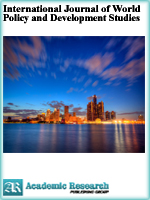International Journal of World Policy and Development Studies
Online ISSN: 2415-2331
Print ISSN: 2415-5241
Print ISSN: 2415-5241
Quarterly Published (4 Issues Per Year)

Archives
Volume 5 Number 10 October 2019
Unseen Contributor to the Tensions in Georgia
Authors: Vladimir Liparteliani
Pages: 100-105
DOI: doi.org/10.32861/ijwpds.510.100.105
Abstract
The purpose of the research is to examine importance of Georgia’s current relations with its neighboring Russia and Azerbaijan and to estimate risks that deterioration of these relations can bring to Georgia’s economy. Of particular interest is to understand who stands behind the tensions happened in Georgia in the run-up to the tourist season of 2019 or at least to figure out possible motives behind the events. Interdependence of the states is analyzed through historical review of their relations and estimation of their current mutual interests. Considering risks and aspirations of the sides in the tensions, the motives behind are suggested. The data received depicts that none of these tensions were initiated by Georgia following its interests, on the contrary, its ruling party’s most visible achievement had been the ability to maintain positive and beneficial relations with both Russia and Azerbaijan. Thus, the Georgian government considered to be a victim in this case. The paper concludes that Georgian government is unable to react on provocations in a timely fashion due to absence of agreement in the ruling party and being quite fragile for outside forces that try to influence the country’s political processes. Unless Georgia manages to build more interdependent or less dependent relations with superpowers, it will be unable to avoid repetition of such manipulations.
Developments on Helix Theory: Exploring a Micro-Evolutionary Repositioning in Stra.Tech.Man Terms
Authors: Charis Vlados ; Dimos Chatzinikolaou
Pages: 87-99
DOI: doi.org/10.32861/ijwpds.510.87.99
Abstract
This study explores a potential reposition of the triple helix model of university-industry-government relations in terms of micro-level analysis. In this direction, we evaluate the development of helix theory over time, by reviewing the relevant literature divided into three successive phases: the phase of theoretical foundation, the phase of conceptual expansion, and the phase of recent developments and systematic attempts of implementation. In this conceptual study, we estimate that a refocused triple helix model in terms of local development, by placing at the center of analysis the “living organization’s” dynamics in Stra.Tech.Man terms (synthesis of Strategy-Technology-Management), can be a possible direction of analytical enrichment.



